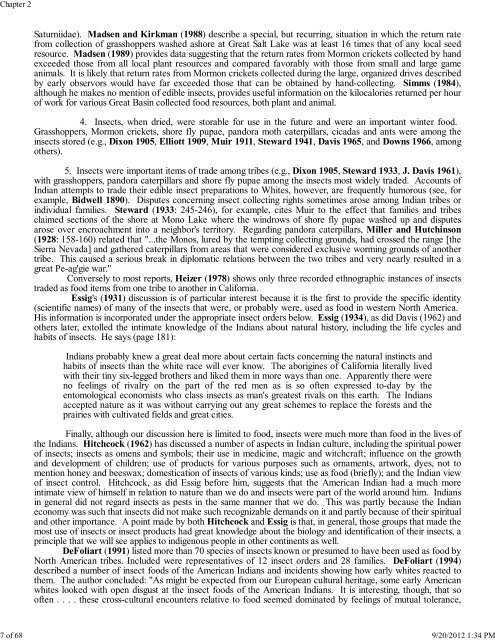Chapter 2. Insect Foods of North American Indigenous Populations ...
Chapter 2. Insect Foods of North American Indigenous Populations ...
Chapter 2. Insect Foods of North American Indigenous Populations ...
Create successful ePaper yourself
Turn your PDF publications into a flip-book with our unique Google optimized e-Paper software.
<strong>Chapter</strong> 27 <strong>of</strong> 68 9/20/2012 1:34 PMSaturniidae). Madsen and Kirkman (1988) describe a special, but recurring, situation in which the return ratefrom collection <strong>of</strong> grasshoppers washed ashore at Great Salt Lake was at least 16 times that <strong>of</strong> any local seedresource. Madsen (1989) provides data suggesting that the return rates from Mormon crickets collected by handexceeded those from all local plant resources and compared favorably with those from small and large gameanimals. It is likely that return rates from Mormon crickets collected during the large, organized drives describedby early observors would have far exceeded those that can be obtained by hand-collecting. Simms (1984),although he makes no mention <strong>of</strong> edible insects, provides useful information on the kilocalories returned per hour<strong>of</strong> work for various Great Basin collected food resources, both plant and animal.4. <strong>Insect</strong>s, when dried, were storable for use in the future and were an important winter food.Grasshoppers, Mormon crickets, shore fly pupae, pandora moth caterpillars, cicadas and ants were among theinsects stored (e.g., Dixon 1905, Elliott 1909, Muir 1911, Steward 1941, Davis 1965, and Downs 1966, amongothers).5. <strong>Insect</strong>s were important items <strong>of</strong> trade among tribes (e.g., Dixon 1905, Steward 1933, J. Davis 1961),with grasshoppers, pandora caterpillars and shore fly pupae among the insects most widely traded. Accounts <strong>of</strong>Indian attempts to trade their edible insect preparations to Whites, however, are frequently humorous (see, forexample, Bidwell 1890). Disputes concerning insect collecting rights sometimes arose among Indian tribes orindividual families. Steward (1933: 245-246), for example, cites Muir to the effect that families and tribesclaimed sections <strong>of</strong> the shore at Mono Lake where the windrows <strong>of</strong> shore fly pupae washed up and disputesarose over encroachment into a neighbor's territory. Regarding pandora caterpillars, Miller and Hutchinson(1928: 158-160) related that "...the Monos, lured by the tempting collecting grounds, had crossed the range [theSierra Nevada] and gathered caterpillars from areas that were considered exclusive worming grounds <strong>of</strong> anothertribe. This caused a serious break in diplomatic relations between the two tribes and very nearly resulted in agreat Pe-ag'gie war."Conversely to most reports, Heizer (1978) shows only three recorded ethnographic instances <strong>of</strong> insectstraded as food items from one tribe to another in California.Essig's (1931) discussion is <strong>of</strong> particular interest because it is the first to provide the specific identity(scientific names) <strong>of</strong> many <strong>of</strong> the insects that were, or probably were, used as food in western <strong>North</strong> America.His information is incorporated under the appropriate insect orders below. Essig (1934), as did Davis (1962) andothers later, extolled the intimate knowledge <strong>of</strong> the Indians about natural history, including the life cycles andhabits <strong>of</strong> insects. He says (page 181):Indians probably knew a great deal more about certain facts concerning the natural instincts andhabits <strong>of</strong> insects than the white race will ever know. The aborigines <strong>of</strong> California literally livedwith their tiny six-legged brothers and liked them in more ways than one. Apparently there wereno feelings <strong>of</strong> rivalry on the part <strong>of</strong> the red men as is so <strong>of</strong>ten expressed to-day by theentomological economists who class insects as man's greatest rivals on this earth. The Indiansaccepted nature as it was without carrying out any great schemes to replace the forests and theprairies with cultivated fields and great cities.Finally, although our discussion here is limited to food, insects were much more than food in the lives <strong>of</strong>the Indians. Hitchcock (1962) has discussed a number <strong>of</strong> aspects in Indian culture, including the spiritual power<strong>of</strong> insects; insects as omens and symbols; their use in medicine, magic and witchcraft; influence on the growthand development <strong>of</strong> children; use <strong>of</strong> products for various purposes such as ornaments, artwork, dyes, not tomention honey and beeswax; domestication <strong>of</strong> insects <strong>of</strong> various kinds; use as food (briefly); and the Indian view<strong>of</strong> insect control. Hitchcock, as did Essig before him, suggests that the <strong>American</strong> Indian had a much moreintimate view <strong>of</strong> himself in relation to nature than we do and insects were part <strong>of</strong> the world around him. Indiansin general did not regard insects as pests in the same manner that we do. This was partly because the Indianeconomy was such that insects did not make such recognizable demands on it and partly because <strong>of</strong> their spiritualand other importance. A point made by both Hitchcock and Essig is that, in general, those groups that made themost use <strong>of</strong> insects or insect products had great knowledge about the biology and identification <strong>of</strong> their insects, aprinciple that we will see applies to indigenous people in other continents as well.DeFoliart (1991) listed more than 70 species <strong>of</strong> insects known or presumed to have been used as food by<strong>North</strong> <strong>American</strong> tribes. Included were representatives <strong>of</strong> 12 insect orders and 28 families. DeFoliart (1994)described a number <strong>of</strong> insect foods <strong>of</strong> the <strong>American</strong> Indians and incidents showing how early whites reacted tothem. The author concluded: "As might be expected from our European cultural heritage, some early <strong>American</strong>whites looked with open disgust at the insect foods <strong>of</strong> the <strong>American</strong> Indians. It is interesting, though, that so<strong>of</strong>ten . . . . these cross-cultural encounters relative to food seemed dominated by feelings <strong>of</strong> mutual tolerance,
















